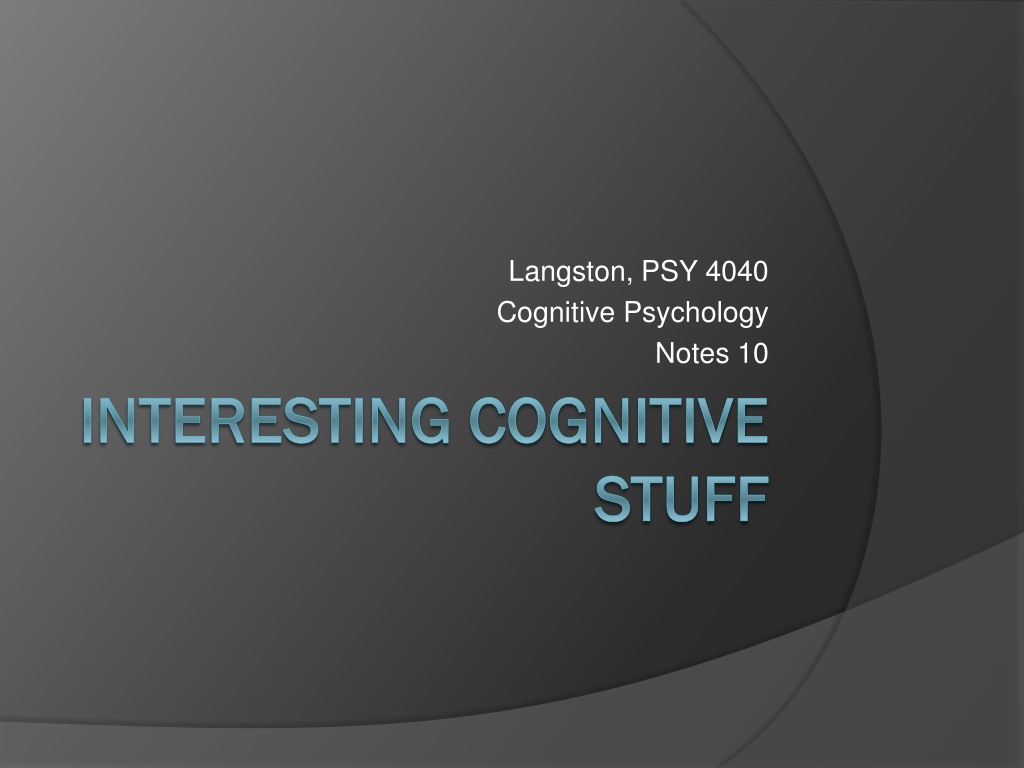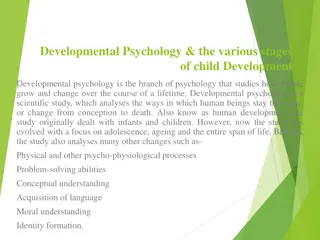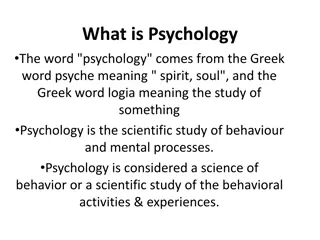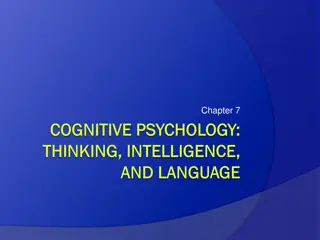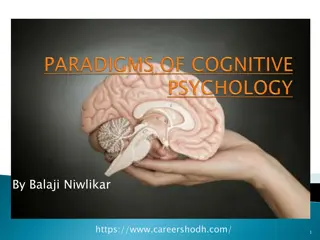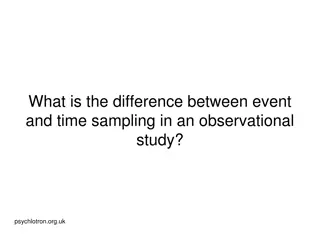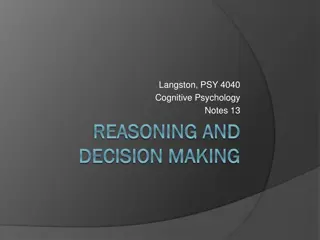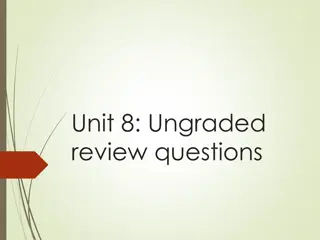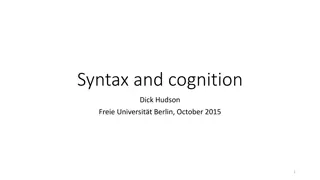Exploring Higher Cognitive Processes in Cognitive Psychology
Moving into higher cognition, the study delves into five key areas: categorization, language structure, language meaning, reasoning/decision making, and human factors. It also discusses memory aspects like counting-out rhymes, emphasizing the significance of oral tradition in memory transmission through ritualized activities. By analyzing these materials, insights into memory systems and pre-literate societies are gained.
Download Presentation

Please find below an Image/Link to download the presentation.
The content on the website is provided AS IS for your information and personal use only. It may not be sold, licensed, or shared on other websites without obtaining consent from the author. Download presentation by click this link. If you encounter any issues during the download, it is possible that the publisher has removed the file from their server.
E N D
Presentation Transcript
Langston, PSY 4040 Cognitive Psychology Notes 10 INTERESTING COGNITIVE INTERESTING COGNITIVE STUFF STUFF
Where We Are We re moving into higher cognition. We ve completed our tour of the cognitive architecture and now we re going to look at how you use it. We re going to hit five areas: Categorization Language Structure Language Meaning Reasoning/Decision making Human factors
Where We Are We have covered categorization, which can be incorporated into our discussion of semantic long-term memory. We have some additional higher cognitive processes to consider, but I want to take a little detour to talk about some things that don t fit, but have important implications.
Where We Are We ll look at three things: Other aspects of memory that are derived from a real-world (as opposed to laboratory) context. A longer-term view of memory, memory for the lifespan.
Counting-out Rhymes Counting-out rhymes are used to determine who is it. Complete the following: Eenie, meenie One potato, two potato
Counting-out Rhymes I predict: Eeenie, meenie, miney, mo Catch a tiger by the toe If he hollers, let him go Five potato, six potato One potato, two potato Three potato, four Eenie, meenie, miney, mo Seven potato, more
Counting-out Rhymes Why study these? They re designed to be memorized: They serve a role in a ritualized activity. Cheating in this activity has important consequences. The people who use them are generally pre-literate, and can t consult the books to use them; they have to be transmitted via oral tradition. So: What can we learn about memory from material meant to work in the memory system?
Counting-out Rhymes Why study these? Almost everyone knows them (there is some variability, but that can be informative). So: We have lots of potential data points.
Counting-out Rhymes The first question: Is there a distinct genre? Or: Do these rhymes share properties in common that could teach us about memory? The second question: What do they tell us about memory?
Counting-out Rhymes Rubin (1995): Study the 24 most common rhymes in English and the 24 least common. Try to see if there are differences that might influence which ones are popular and which aren t.
Counting-out Rhymes A sample of the genre: Property Common Rare Lines per rhyme 4.56 4.04 Words per rhyme 21.42 16.96 Word repetition .19 .14 Rhyme .24 .21 Alliteration .25 .21 Assonance .25 .26 End rhyme .79 .63 Poetic words on beats Meaningful words .90 .79 .79 .77 Adapted from Rubin (1995, p. 231)
Counting-out Rhymes What it means: The rare and common are pretty similar, suggesting that there is a genre and the rules for making up rhymes are followed for all of them. Properties: Nonsense words (magic, ritual). Lots of poetics. Four-line rhymes with four beats per line (counting). Poetic words on beats (especially for common). Not much emphasis on meaning.
Counting-out Rhymes What does this do? Constraint satisfaction: Write down a word that rhymes with most. Write down a device for calculating numbers. Write down a word that rhymes with shuttle. Write down a spiritual figure. Write down a word that rhymes with peanut. Write down a spiritual figure that rhymes with most. Combining constraints makes the choice easy because the burden has been moved from memory to the poetics.
Counting-out Rhymes What does this do? Constraint satisfaction: Write down a word that rhymes with most. Write down a spiritual figure. Write down a spiritual figure that rhymes with most. There are a lot of words in English that fit one constraint (host, toast, boast, coast ), but not many that fit both. If you re telling a story and you know the properties of the word, you don t have to remember it, it s the one (or one of a few) that will work.
Counting-out Rhymes Let s look at the structure of one line: Eenie, meenie, miney, mo: Front to back progression (e, i, o). Repetition of eenie in meenie. Alliteration of meenie, miney, mo. Rhyme eenie, meenie, miney. Mo will rhyme with toe and go. /n/ repeats in eenie, meenie, miney The line repeats at the end. Mo decides who is it and falls on a beat (won t work if it s monie).
Counting-out Rhymes In other words, trying to change anything about the line would require a change to a lot of things. For example, the Scottish version is Eena, deena, dina, do. The constraints make the rhyme carry most of the burden, not memory.
Counting-out Rhymes Variability in people s recall also tells us about memory and the genre. Most of the changes are to the meaning: Change Percent Replace story line (if he hollers, make him pay ) Change tiger (next slide) Miscellaneous 28% 31% 38% Adapted from Rubin (1995, p. 240)
Counting-out Rhymes What about the tiger? Originally, it was the n-word. When it had to go, what came in? Rubin (1995): 73 tigers, 10 monkeys, 10 rabbits, 2 fellows, 2 piggies, and one bunny, blackbird, buyer, chicken, doggie, froggie, and wiffer waffer.
Counting-out Rhymes The top 2: Tiger alliterates with toe. Monkey alliterates with meenie, miney, mo. They had to be two-syllable (check the list). In other words, when the rhyme changed, there was a period of instability and then the system settled on a substitution that improved the poetics.
Counting-out Rhymes Tiger: Year learned N-word Tiger 1953 40% 56% 1965 6% 70% 1976 .5% 84% 1978 0% 100% Adapted from Rubin (1995, p. 242)
Counting-out Rhymes What about historical changes? Most popular until 1860: Onery, twory, tickery, tevin Alabone, crackabone, ten and eleven Pin, pam, musky dam Tweedleum, twaddleum, twenty-one Where did this go and why?
Counting-out Rhymes Rubin (1995, p. 248)
Counting-out Rhymes New favorites: Tend to be more meaningful (dual sources of constraint). Tend to be used by younger children.
Counting-out Rhymes What did we learn about memory by looking at materials designed to be memorized?
Counting-out Rhymes We can also test the existence of a genre by looking at rhymes from a different culture. Rubin, Ciobanu, and Langston (1997). Collect counting-out rhymes from Romanian school children in Bucharest.
Counting-out Rhymes Rhyme: English translation: From the Pacific ocean A little fish came out And on his tail was written Out goes you Rhyme: English translation: On a bar Din oceanul Pacific A iesit un peste mic Si pe coada lui scria Iesi afara dumneata Or: Te iubesc, nu ma uita Pe o bara Se caca o cioara Ga, ga, ga A crow was pooping Ga, ga, ga Drept in gura ta Right in your mouth I love you, don t forget me
Counting-out Rhymes What you find is: The genre holds up (the importance of poetics as a source of constraint). The variability reflects changes in meaning over changes in poetics. This suggests that what we found out is actually a property of memory.
Memory Over the Lifespan When you are older (>65), what will you remember about your life? This is a good cognitive psychology question for a variety of reasons: The method used to find out takes some creativity. The results are interesting.
Memory Over the Lifespan Method: We can cue people with common words and ask them to write about the first memory that comes to mind (clear and distinct, and they participated in it). After they write about it, they date it (Robinson, 1976). To validate the memory, we could ask about things that can be verified (e.g., news, music, sports). If you plot the number of memories produced against age, you get a graph like this (Jansari & Parkin, 1996)
Memory Over the Lifespan Jansari & Parkin (1996, p. 87)
Memory Over the Lifespan The curve has three parts: Recency: Rapid fall-off that is similar to laboratory studies. Infantile amnesia: Not much before the age of 3 or so. The reminiscence bump: More memories are in the 10-30 range than we would expect.
Memory Over the Lifespan Bump properties: Very robust across different kinds of memories and tasks. Not so much for younger adults. Jansari and Parkin (1996) tested the hypothesis that this was because younger people are biased towards recency. The figure above is their data for 46-50 year-olds. Note that when they are told not to include recent memories, the bump grows. Here are the data for 56-60
Memory Over the Lifespan Jansari & Parkin (1996, p. 87)
Memory Over the Lifespan Implication: Some aspect of your self will always be in the bump region (to the extent that your you is defined by memories). Make it count.
Memory Over the Lifespan The interesting methodological part: Why does this happen? Rubin and Schulkind (1997): Demand characteristics. People search here longer. Bump more important. Bump in central narrative of your life. Bump novel and distinctive. Bump vivid and emotional. Bump encoded differently.
Memory Over the Lifespan How do we tell? Demand characteristics. People think those are the memories you want, so they give them to you. Biasing instructions (telling them to be biased in various ways) don t change the curves. People search here longer. If it s an old memory, I know it s harder to retrieve so I work longer; if it s recent and I don t know it right away, I just quit. No response time differences.
Memory Over the Lifespan How do we tell? Bump more important. These memories are the most important in your life narrative. Not when people rate importance. Bump in central narrative of your life. These memories are central to the narrative of your life (think of the kinds of things that happen here). Bump memories not more significant. Both of these assume nothing important happens later in life, and that s wrong.
Memory Over the Lifespan How do we tell? Bump novel and distinctive. Things that are distinct are easier to retrieve, and more distinct things happen in this period. Not rated that way. Bump vivid and emotional. Vividness and emotionality affect memory. Not rated that way.
Memory Over the Lifespan How do we tell? What s left? Note that this is a kind of strong inference exercise where we rule out all of the competing hypotheses and have this one left over. Bump encoded differently. This appears to be the winning answer. Maybe there is something about brains and typical lifespans during evolution that make this period special
Final Thoughts Note how both of these topics take a different approach to memory. We re not asking about how to study better for a test, we re asking: What do things look like when they re designed to be remembered? What will you remember about life? This change in perspective to get outside of the paradigm could help us see things we wouldn t otherwise see.
END OF INTERESTING END OF INTERESTING COGNITIVE COGNITIVE STUFF SHOW STUFF SHOW
